Coma SkyWalker
"Coma SkyWalker" allows you to interactively patrol (some of) the Hubble Space Telescope Images.(It works with Mozilla and Internet Explorer, but may not with some other browsers.)
Image Gallery
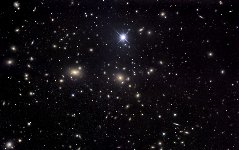 |
 |
 |
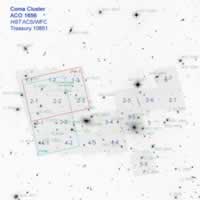 |
|
 |
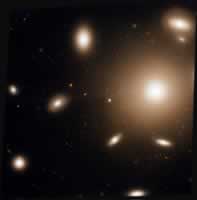 |
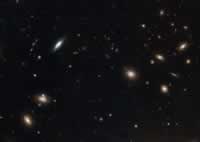 |
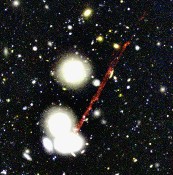 |
|
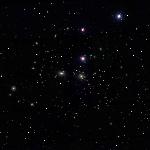 |
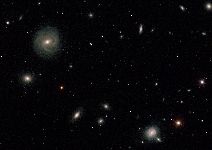 |
 |
 |
 |
1. A ground-based image roughly corresponding to the rectangular tiled area, referred to as the `core region' of the Coma galaxy cluster, which is shown in the two images to the right. While some massive galaxies dominate the landscape, thousands of "dwarf galaxies" reside in this cluster. [Image credit & copyright: Jim Misti (Misti Mountain Observatory)]
2. Overlay on a Digital Sky Survey image of the 82 Advanced Camera for Surveys (ACS) fields from the approved Treasury Survey. [Image credit: David Carter]
3. Overlay on a Digital Sky Survey image of the 25 ACS fields observed before the ACS failure on the 27th of January, 2007. [Image credit: David Carter]
4. Tiling pattern of observations overlaid on a wide-field, ground-based, photographic image of the Coma galaxy cluster. [Image credit: NASA/STScI/Coma HST ACS Treasury Team]
5. The right image is from a ground-based telescope while the left image is from HST, clearly revealing the improvement in image quality. Shown is a bright Coma cluster spiral galaxy gravitationally interacting with other galaxies and stirring up clouds of dust. [Image credit: Zolt Levay/STScI, NASA, Coma HST ACS Treasury Team]
6. NGC 4874, the brightest galaxy in this HST image, is one of the largest and most massive galaxies in the Universe. It is some 10 times larger than our own galaxy, the Milky Way, and may contain one trillion stars. [Image credit: NASA/STScI/Coma HST ACS Treasury Team]
7. Ground-based image of the Coma cluster of galaxies. This image fits into the central left of image Number 1. Can you match the galaxies? [Image credit: NASA/STScI/Coma HST ACS Treasury Team]
8. As above.
9. Subaru composite image of galaxy D100 and its filament of ionized hydrogen gas. D100 is the lower right galaxy, among the three galaxies in the center of the image. The filament is the red streak extending to the upper right of D100. (The red, green, and blue colors show the Hα, R, and B band light, respectively.) [Image credit: Subaru Media Release]
10. Optical ground-based image based on SDSS g',r',i' filters (www.sdss.org). This region of sky corresponds to the top left quadrant of image 2 and 3. [Image composition: Thomas H. Puzia & Neal Miller]
11. As above, but showing a zoomed in region from the lower left hand side of image 10.
12. Within the core of the Coma galaxy cluster is the giant elliptical galaxy NGC 4874 . In this HST image NGC 4874 (upper middle) is surrounded by a swarm of globular clusters; virtually every "point-source" in this image is a globular cluster. [Image credit: Thomas Puzia, Herzberg Institute of Astrophysics.]
13. A zoomed in version of Figure 10, better revealing the three-dimensional halo of globular clusters around NGC 4874.
14. Subaru composite image of galaxy RB199 (right of image) and its unusual, 260,000 light-year long,
knotted thread-like ejecta.
The "fireballs" along these filaments are active sites of star formation.
Filters used: H-alpha narrow band (671 nm), Blue (450 nm) and Red (650 nm).
[Image credit: Subaru Media Release]
You Tube
The Coma galaxy cluster (ESOcast: Hubble's Universe Unfiltered).
Unusual Spiral Galaxy in the Coma Galaxy Cluster (Hubblecast, ESA/Hubble ESO).
Zooming into galaxy NGC 4921 (ESA/Hubble).
Hubble's Sweeping View of the Coma Cluster of Galaxies.

